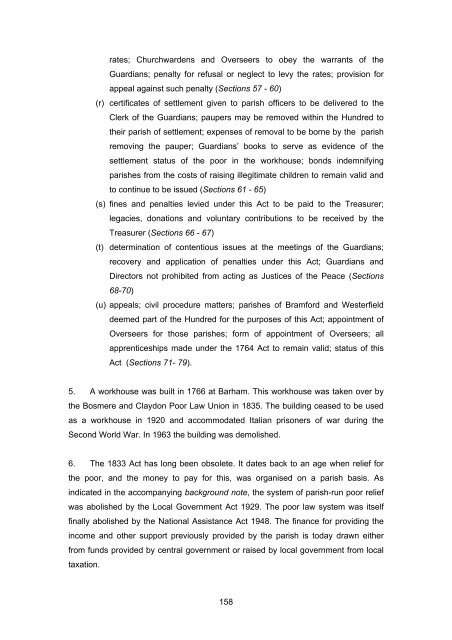Poor Relief - Law Commission
Poor Relief - Law Commission
Poor Relief - Law Commission
Create successful ePaper yourself
Turn your PDF publications into a flip-book with our unique Google optimized e-Paper software.
ates; Churchwardens and Overseers to obey the warrants of the<br />
Guardians; penalty for refusal or neglect to levy the rates; provision for<br />
appeal against such penalty (Sections 57 - 60)<br />
(r) certificates of settlement given to parish officers to be delivered to the<br />
Clerk of the Guardians; paupers may be removed within the Hundred to<br />
their parish of settlement; expenses of removal to be borne by the parish<br />
removing the pauper; Guardians’ books to serve as evidence of the<br />
settlement status of the poor in the workhouse; bonds indemnifying<br />
parishes from the costs of raising illegitimate children to remain valid and<br />
to continue to be issued (Sections 61 - 65)<br />
(s) fines and penalties levied under this Act to be paid to the Treasurer;<br />
legacies, donations and voluntary contributions to be received by the<br />
Treasurer (Sections 66 - 67)<br />
(t) determination of contentious issues at the meetings of the Guardians;<br />
recovery and application of penalties under this Act; Guardians and<br />
Directors not prohibited from acting as Justices of the Peace (Sections<br />
68-70)<br />
(u) appeals; civil procedure matters; parishes of Bramford and Westerfield<br />
deemed part of the Hundred for the purposes of this Act; appointment of<br />
Overseers for those parishes; form of appointment of Overseers; all<br />
apprenticeships made under the 1764 Act to remain valid; status of this<br />
Act (Sections 71- 79).<br />
5. A workhouse was built in 1766 at Barham. This workhouse was taken over by<br />
the Bosmere and Claydon <strong>Poor</strong> <strong>Law</strong> Union in 1835. The building ceased to be used<br />
as a workhouse in 1920 and accommodated Italian prisoners of war during the<br />
Second World War. In 1963 the building was demolished.<br />
6. The 1833 Act has long been obsolete. It dates back to an age when relief for<br />
the poor, and the money to pay for this, was organised on a parish basis. As<br />
indicated in the accompanying background note, the system of parish-run poor relief<br />
was abolished by the Local Government Act 1929. The poor law system was itself<br />
finally abolished by the National Assistance Act 1948. The finance for providing the<br />
income and other support previously provided by the parish is today drawn either<br />
from funds provided by central government or raised by local government from local<br />
taxation.<br />
158
















